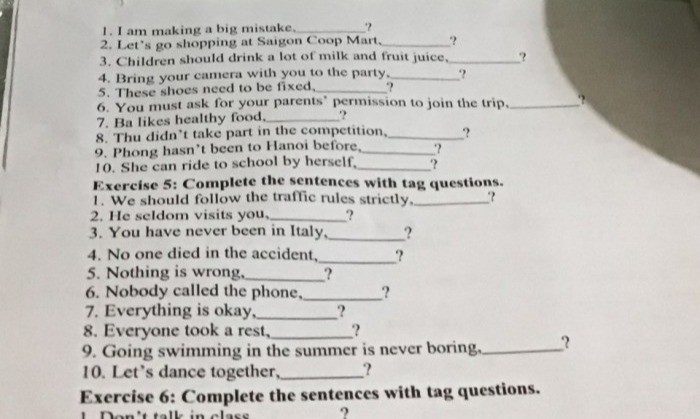**Bài 4:**
1. I am making a big mistake, **am I**?
2. Let’s go shopping at Saigon Coop Mart, **shall we**?
3. Children should drink a lot of milk and fruit juice, **shouldn't they**?
4. Bring your camera with you to the party, **will you**?
5. These shoes need to be fixed, **don't they**?
6. You must ask for your parents' permission to join the trip, **mustn't you**?
7. Ba likes healthy food, **doesn't he**?
8. You didn’t take part in the competition, **did you**?
9. Phong hasn’t been to Hanoi before, **has he**?
10. She can ride to school by herself, **can't she**?
**Giải thích:**
- Các câu hỏi đuôi (tag questions) thường được sử dụng để xác nhận thông tin hoặc để hỏi ý kiến người khác.
- Nếu mệnh đề chính là khẳng định, thì câu hỏi đuôi sẽ là phủ định và ngược lại.
- Ví dụ: "I am making a big mistake" là khẳng định, nên câu hỏi đuôi là "am I?" (phủ định).
**Bài 5:**
1. We should follow the traffic rules strictly, **shouldn't we**?
2. He seldom visits you, **does he**?
3. You have never been in Italy, **have you**?
4. No one died in the accident, **did they**?
5. Nothing is wrong, **is it**?
6. Nobody called the phone, **did they**?
7. Everything is okay, **isn't it**?
8. Everyone took a rest, **didn't they**?
9. Going swimming in the summer is never boring, **is it**?
10. Let’s dance together, **shall we**?
**Giải thích:**
- Tương tự như trên, các câu hỏi đuôi được hình thành dựa trên cấu trúc của mệnh đề chính.
- Nếu mệnh đề chính là khẳng định, câu hỏi đuôi sẽ là phủ định và ngược lại.
- Ví dụ: "We should follow the traffic rules strictly" là khẳng định, nên câu hỏi đuôi là "shouldn't we?" (phủ định).
Trang chủ
Giải bài tập Online
Đấu trường tri thức
Dịch thuật
Flashcard - Học & Chơi
Cộng đồng
Trắc nghiệm tri thức
Khảo sát ý kiến
Hỏi đáp tổng hợp
Đố vui
Đuổi hình bắt chữ
Quà tặng và trang trí
Truyện
Thơ văn danh ngôn
Xem lịch
Ca dao tục ngữ
Xem ảnh
Bản tin hướng nghiệp
Chia sẻ hàng ngày
Bảng xếp hạng
Bảng Huy hiệu
LIVE trực tuyến
Đề thi, kiểm tra, tài liệu học tập








 Trả lời nhanh trong
Trả lời nhanh trong 



 Xem thêm
Xem thêm  Thưởng th.12.2024
Thưởng th.12.2024 Bảng xếp hạng
Bảng xếp hạng